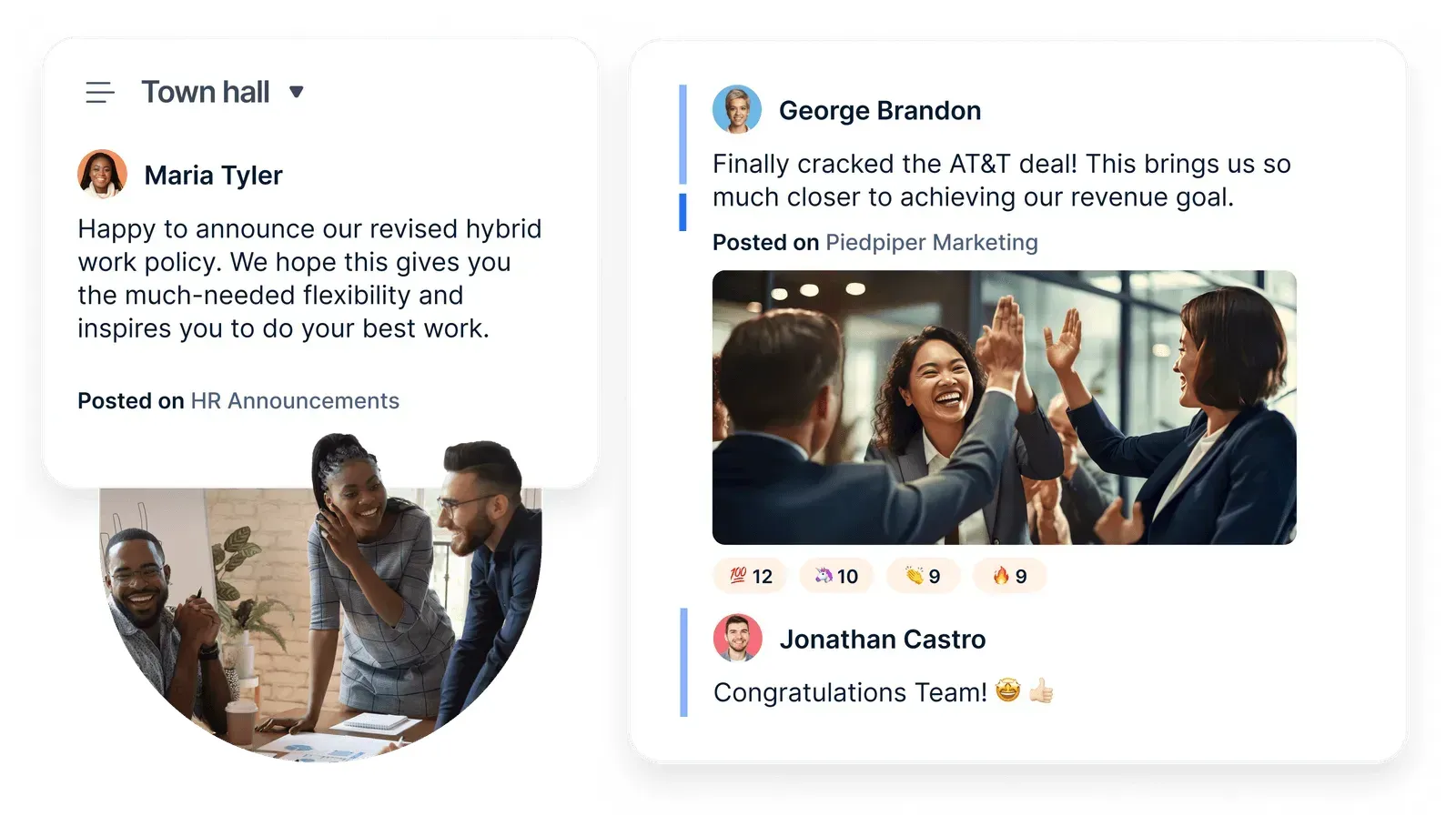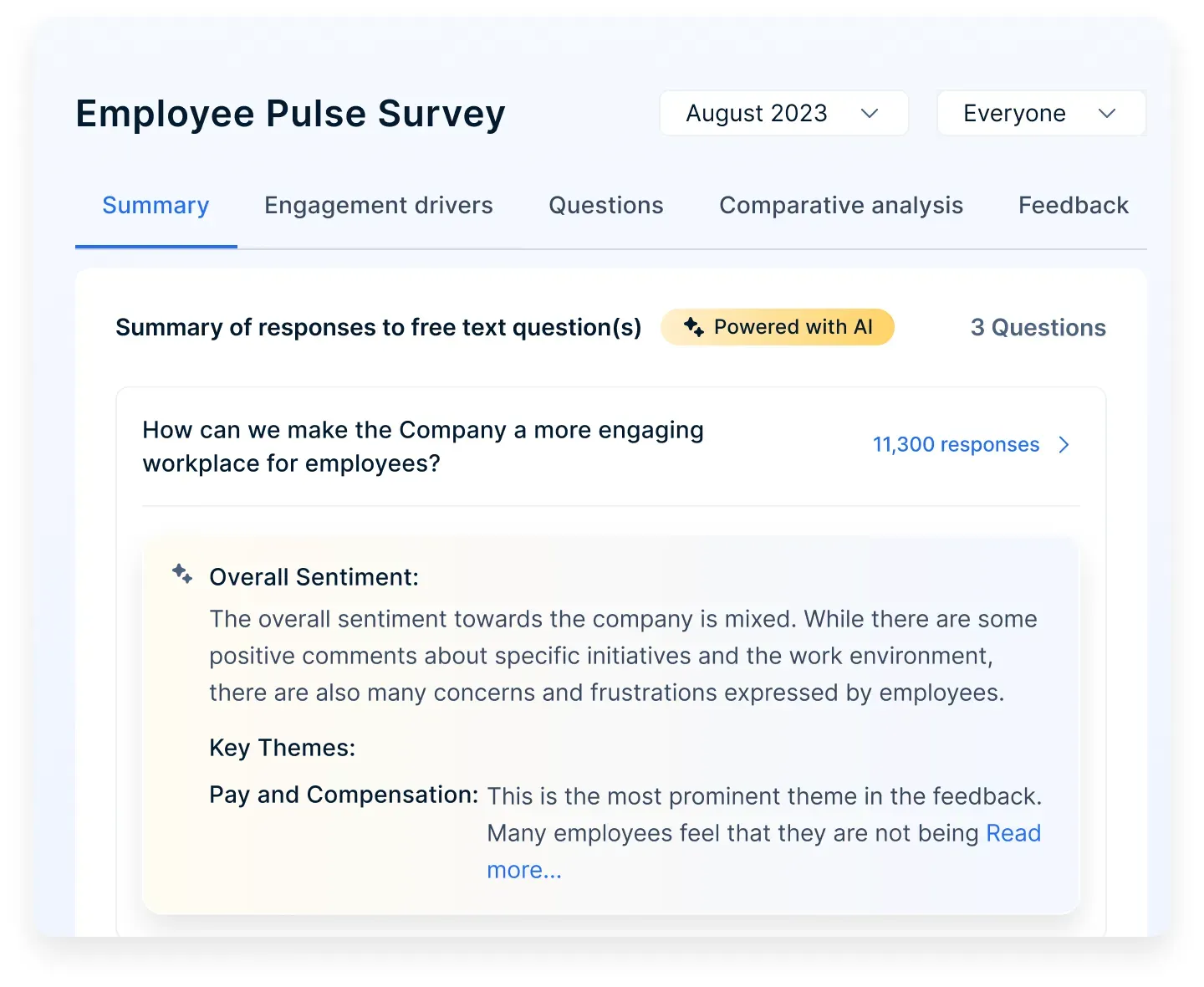En esta página
- Understanding remote work and employee engagement
- ¿Cómo involucrar a los empleados remotos con recompensas y reconocimiento?
- ¿Cómo involucrar a los empleados remotos dándoles feedback continuo?
- ¿Cómo implicar a los empleados remotos mejorando la comunicación interna?
- How do you engage remote employees using perks and benefits?
- ¿Cómo involucrar a los empleados remotos localizando recompensas y beneficios?
- 6 More employee engagement activities for remote employees
- How to leverage Empuls for engaging remote employees
- Conclusión
Remote work isn’t going anywhere. What started as a temporary shift has now become a long-term reality for many teams across industries. But with that shift comes a new challenge: how to engage remote employees in ways that feel personal, consistent, and meaningful—even without the office water cooler.
Engaging remote employees isn’t just about checking tasks off a list—it’s about making them feel like they’re still part of the team, no matter where they work from. And while the tools have changed, the goal hasn’t: connection, motivation, and shared purpose.
If you’re wondering what really works regarding employee engagement for remote employees, this blog is your playbook. We’re sharing smart, sustainable strategies for keeping remote employees engaged—not just today, but for the long term.
Understanding remote work and employee engagement
Remote work has redefined how teams function, communicate, and connect. While flexibility and autonomy are major benefits, they also come with a unique set of challenges—especially regarding employee engagement for remote employees. Employees can quickly feel disconnected or overlooked without physical interactions or spontaneous conversations.
Engagement in a traditional office happens naturally—through casual chats, team lunches, or in-person recognition. But in a remote setup, engaging remote employees requires more intention. It’s about creating moments that matter, even if they happen through a screen.
True engagement in remote work isn't just about productivity—it’s about emotional connection, a sense of belonging, and clear communication. When employees feel aligned with the company’s goals and supported in their work, they’re more likely to stay motivated, contribute actively, and bring their best selves to work—wherever possible.
So, keeping remote employees engaged isn’t a one-size-fits-all solution. It’s about understanding what makes them tick and feel included, and how to create a culture that reaches them—without being in the same room.
¿Cómo involucrar a los empleados remotos con recompensas y reconocimiento?
He aquí cinco formas eficaces de implicar a los empleados remotos con recompensas y reconocimiento:
1. Recognize the reasonable efforts and behavior
Sólo en Estados Unidos, 4,3 millones de personas trabajan desde casa al menos la mitad de su jornada laboral, lo que denota la contribución del "trabajo a distancia" a la mano de obra del país.
Since employees continue to add value to the business, even while working remotely, it is essential to recognize their exceptional contributions.
Mechanisms must be implemented to track and identify such efforts to reward such behaviors in time and enhance employee experience. Value-based awards, for instance, can go a long way in recognizing commendable efforts and behaviors - despite the less-than-perfect remote working conditions.
2. Recognize and appreciate in public
Recognition in public needs fundamental rethinking when your employees are remote working. With the help of organizational groups of communication platforms like Slack or teams or employee engagement platforms like Empuls, recognition in public occurs. Distributed teams can not be recognized in person, and, hence public recognition tools work best to let others know about their work.
3. Don’t hesitate to say thanks, kudos, and high fives to the team
En la actualidad, dos tercios de los trabajadores remotos trabajan en equipo, por lo que el envío de tarjetas electrónicas de agradecimiento puede marcar la diferencia en la gestión de todos ellos en sus equipos.
Communicating appreciation to team members, remote or otherwise, never becomes too much- because these make your team members clearer on how they are adding value to the team goals. Celebrating small wins and small good work done - can all go a long way to help them sustain and thrive in the remote work environment.
4. Send your remote teams a surprise gift card or an experience reward
It is projected that by 2028, 73% of all departments will have remote workers - in other words, engaging a remote team member will become an essential part of team management.
One of the great ways to appreciate your remote working employees is with a surprise gift to let them know their contributions are counted. These gift vouchers can generally be redeemed on various brands and events - based on the employees’ interests, like a favorite movie or a book.
5. Embed recognition in your company culture
Aunque tradicionalmente el reconocimiento ha sido descendente, nunca ha sido tan importante democratizar la actividad de reconocimiento si tiene empleados remotos. Los miembros de equipos remotos trabajan en compartimentos estancos con menos interacciones interfuncionales que, de otro modo, serían posibles en un entorno de oficina.
Todos los directivos y compañeros que interactúen con un empleado deben estar capacitados para reconocerlo ofreciéndoles numerosas oportunidades de apreciarse mutuamente, inculcando así una cultura de reconocimiento. Una plataforma social que permite recompensar a los compañeros y a los spots es un entorno ideal para fomentar la cultura del reconocimiento.
¿Cómo involucrar a los empleados remotos dándoles feedback continuo?
He aquí cómo dar feedback a los empleados remotos puede comprometerlos mejor:
6. Proactively share positive feedback and good news.
La oportunidad del reconocimiento es el factor más importante para su eficacia. Es importante una comunicación constante y coherente, especialmente sobre las cosas buenas del entorno,
These messages help in keeping morale and productivity high for remote employees. These include appreciating good work done or announcing a company achievement - every bit of positivity counts.
7. If a client has appreciated the efforts of a team, acknowledge the efforts of that team.
Like how all roads lead to Rome, an organization's efforts must be directed towards creating a valuable customer experience. If a customer appreciates such an effort, make sure to celebrate it in the best way. Announce it in the company social group, talk about what went well, and name every one of the contributors. Such appreciations clearly signal employees about the customer-centricity values that need to live.
¿Cómo implicar a los empleados remotos mejorando la comunicación interna?
Mejorar la comunicación entre empleados remotos ayuda a involucrarlos
8. Keep communication open
Last but not least, you should always keep your communication as open as possible. By showing that you are willing to communicate properly with your employees, they will also be more willing to communicate with you about anything that troubles them.
Establece varios canales de comunicación: mensajería, correo electrónico y otras plataformas. Hágales saber sus objetivos y expectativas para el futuro e intente no ocultarles asuntos importantes. Y, por supuesto, recuerda tener un enfoque individual para cada uno de tus empleados, incluso cuando se trate de comunicación interna.
9. Use an engagement tool to spread happiness
La felicidad y la motivación son contagiosas. Por eso es importante que las conversaciones felices -sobre captación de nuevos clientes o comentarios de grandes clientes- no se hagan en silos, a través de chats o correos electrónicos. A pesar de los diversos avances en las tecnologías de colaboración, el correo electrónico sigue siendo el medio de comunicación predominante con los trabajadores remotos.
Engagement tools like Empuls work best to really drive a culture of motivation and appreciation by circulating such motivating messages across the organization.
10. Conduct electronic brainstorming sessions
Los empleados afirman que las sesiones de brainstorming son las más difíciles durante el trabajo a distancia porque no están físicamente presentes en una sala de reuniones.
Las plataformas modernas pueden eludir y llevar a cabo eficazmente sesiones de brainstorming mediante conversaciones de grupo específicas.
For instance, in Empuls, managers can create a dedicated brainstorming group (for conversations requiring documentation) or a group chat to discuss action items quickly.
11. Call out people who have done a good online demo, a webinar, or remotely
Remote working is a hitherto workforce management opportunity for many organizations, and immense learning must be made. In addition to organization values, you need to reinforce practices that help remote working work. Like hosting webinars or virtual events, appreciate employees who disrupted their functions to adapt and excel during remote work.
12. Give a surprise visit to your remote team members and take them out for lunch or dinner
Sometimes, meeting face-to-face can become significant in working efficiently with each other. Only when people spend time with each other will they understand each other the best way. Make way to such conversations by flying down to meet your remote team members occasionally.
13. Build a community around work, hobbies, interests, etc. for remote workers
While it is only natural to feel disconnected while remotely working, virtual communities are an excellent way to bring together employees who have common interests, which could also include remote employees.
When there is active community involvement, the feeling of isolation is reduced. Hence involve them in virtual communities in Empuls like any sports, hobbies, charity, book reading, and training.
How do you engage remote employees using perks and benefits?
Providing perks and bonuses is one of the best ways to show that you appreciate and value your employees. Gift cards, discounts, extra vacation days, etc., can be great perks and bonuses.
A more effective way to use such bonuses is by personalizing them to every employee. Think about it as an extension of your approach to every employee in every other aspect of their work. If one employee prefers one store over another, it’s worth giving them a gift card to that store instead of just sticking to a single type of gift card for everyone.
14. Technology perks
The day-to-day WFH tools can significantly impact their productivity and job satisfaction. An extra monitor, a tablet, better headphones, a laptop upgrade, an internet connection, or new software can be beneficial. Consider giving employees an annual technology allowance to pick and choose these benefits.
15. Home service perks
If taken care of, a few critical services might add great value to the remote employees’ daily lives. It should also help your team keep things running smoothly at home. These services could be cleaning, gardening, laundering, daycare, food delivery, or cooking.
Evernote offers home cleaning services, and JibJab Media provides laundry services for their office and remote employees to help them enjoy their free time.
16. Home workspace
While dedicated teams in the office work towards ensuring their office seating is ergonomic, the conditions in which remote working happens are often overlooked. Offering your remote team a budget for upgrading their home office- should help them sort this out.
17. Take care of their health
An interesting aspect of working from home is that it can be challenging to differentiate between leisure time and work time. Some people could even be obsessed with working more to earn more (if their salaries depend directly on how much work they do).
This is precisely why it’s so crucial that you give your team enough breaks and encourage them to take care of their health. You could even organize daily team exercise sessions held via virtual meetings. Ensure everyone is in the right physical state to participate in the exercises you choose for this routine.
¿Cómo involucrar a los empleados remotos localizando recompensas y beneficios?
Descubra cómo la localización de recompensas y beneficios puede atraer a los empleados remotos.
18. Configure benefits and rewards
La mayoría de los empleados remotos de una empresa trabajan desde distintas ubicaciones geográficas, lo que les impide conocer sus problemas específicos. Las organizaciones no comprenden las necesidades reales de los trabajadores remotos porque no conocen bien sus limitaciones de ubicación. La mejor forma de asegurarse de ello es proporcionarles la flexibilidad necesaria para elegir la solución que mejor se adapte a sus necesidades.
19. Respect their local culture, rituals, and beliefs
Si sus trabajadores remotos proceden de diversas zonas geográficas, es importante tener muy en cuenta su cultura local.
Un ejemplo clásico de estas preferencias culturales es cómo las recompensas individualistas funcionan mejor en Estados Unidos que en China.
Por lo tanto, es importante conocer la cultura regional para ajustar las políticas de retribución y los horarios de trabajo a los rituales locales.
While technology can allow organizations to collaborate, innovate, and co-create with remote team members - trust plays an overarching role in it. Managers need to work extensively towards nurturing intra-team trust and cohesion.
Proporcionar una claridad absoluta de los entregables mediante una comunicación continua les ayudará a contribuir eficazmente a los resultados empresariales. Los sistemas de apoyo, como la formación a distancia de los empleados y las tecnologías digitales, ayudan a acelerar el ritmo.
Once the downsides of “lack of face time” are overcome using robust digital technologies, remote workforces tend to thrive on trust, pervasive communications, and real-time collaboration.
6 More employee engagement activities for remote employees
Here are a few more ideas to keep your remote teams engaged, energized, connected, and genuinely involved in their day-to-day work. These activities go beyond the usual to help build trust, boost morale, and maintain a sense of belonging—even from a distance.
1. Encourage side projects
Al pensar en su equipo y su empresa, es fácil olvidar que sus empleados pueden tener otros intereses en el trabajo o en su vida personal, aparte de su trabajo principal.
For example, someone on your team may want to dedicate 20% of their time to learning automation by becoming part of a project to gain hands-on knowledge. Another team member could be a certified communication coach and take up weekend sessions to help people communicate better.
You can leverage this and ask the employee if they want to coach your team. Encouraging these passions or interests can benefit you, your team, and the company.
2. Grow a welcoming company culture
Growing a welcoming company culture is important for any company, but especially for one with many work-from-home employees. Having a company culture represented in the office is one thing, but it completely differs from establishing this in a digital environment.
Company culture will be closely associated with your company’s communication practices, employee perks and bonuses, and more. In other words, it’s worth looking into the way you treat employees and how satisfied they are with the circumstances.
3. Set meaningful and realistic goals
Setting goals correctly can be one of the best ways to achieve success, which means you need to set both meaningful and realistic goals to motivate your employees. Meaningful goals are the ones your employees can connect to emotionally, while realistic goals will allow your employees to achieve them instead of failing.
Para fijar esos objetivos significativos y realistas, piense en lo que les importa a sus empleados y luego piense en lo que realmente son capaces de conseguir. Evalúa el rendimiento de tu equipo en el pasado y fija objetivos que puedan alcanzarse realmente en el tiempo previsto.
4. Create opportunities for learning
Un gran error que cometen algunas empresas es tratar a sus empleados que trabajan desde casa con menos seriedad que a los que trabajan en la oficina. Pero este no debería ser nunca el caso si quieres tener un equipo de éxito.
Por eso, crear oportunidades de aprendizaje debe ser tan prioritario para usted como lo sería para los empleados normales. El aprendizaje es la mejor manera de que sus empleados adquieran las cualificaciones necesarias para desempeñar su trabajo correctamente. Además, el aprendizaje de nuevas habilidades puede ayudar a sus empleados a abrir nuevas puertas y encontrar nuevas oportunidades para hacer crecer la empresa.
5. Satisfy equipment needs
It may not seem like a priority, but satisfying your employees’ equipment needs is one of the most important things to ensure high-quality work. If your team members don’t have the right equipment to work with, they won’t do anything the way they should.
Moreover, you should remember that this refers to physical equipment and the software your employees need. For example, an employee may want to research the “write my research paper” keyword, but they won’t do this manually. They could even try some free keyword research tools, but in some cases, a paid tool for keyword research could be the only right option.
6. Gamify teamwork
Having a team that can work as a team is essential for the success of your projects. But you can also take an unconventional approach and gamify your teamwork.
Let your team have some fun when brainstorming ideas, and let them do it in a more game-based process, which could lead to them being more creative and coming up with more interesting ideas. Organize some in-office or virtual team-building activities to engage your employees.
How to leverage Empuls for engaging remote employees
Keeping remote employees engaged requires more than just virtual meetings and emails. Empuls provides the tools to create a connected, motivated, and collaborative remote workforce by fostering communication, recognition, and engagement in a digital environment.
1. Build a virtual community with the social intranet

Remote work can feel isolating, but Empuls’ social intranet creates a central space for employees to interact, share updates, and participate in discussions. Teams can collaborate across time zones, celebrate milestones, and stay informed about company news in a dynamic and engaging way.
2. Encourage peer recognition and appreciation

When working remotely, employees often miss out on casual appreciation from colleagues. With Empuls, teams can send instant recognition, give kudos, and celebrate achievements, ensuring every contribution is acknowledged.
3. Use pulse surveys to understand remote employee needs

Remote employees have unique challenges, and regular check-ins help organizations address their concerns. Empuls’ pulse surveys provide real-time feedback on engagement, well-being, and workplace satisfaction, helping HR teams refine policies and improve remote work experiences.
4. Organize virtual engagement activities
Keeping remote teams engaged goes beyond work tasks. Empuls enables fun virtual events, challenges, and contests that strengthen team bonding. Whether it’s virtual coffee chats, trivia games, or interest-based groups, employees can stay connected no matter where they are.
5. Offer rewards, perks, and wellness benefits

Empuls’ customizable rewards and perks motivate employees by recognizing milestones, work anniversaries, and outstanding contributions. Offering wellness benefits, learning rewards, and exclusive discounts helps remote employees feel valued and supported.
By leveraging Empuls, organizations can create an inclusive, engaging, and rewarding remote work culture where employees feel connected, appreciated, and motivated to perform at their best.
Conclusión
Engaging remote employees isn’t about flashy perks or one-off virtual events—it’s about creating consistent, meaningful experiences that make people feel connected, valued, and supported, no matter where they work from. By focusing on open communication, recognition, flexibility, and team connection, you can build a remote culture that thrives.
When you invest in employee engagement for remote employees, you’re not just improving morale—you’re strengthening performance, retention, and company culture as a whole. Keep it personal, keep it intentional, and most importantly, keep your people at the heart of it.






